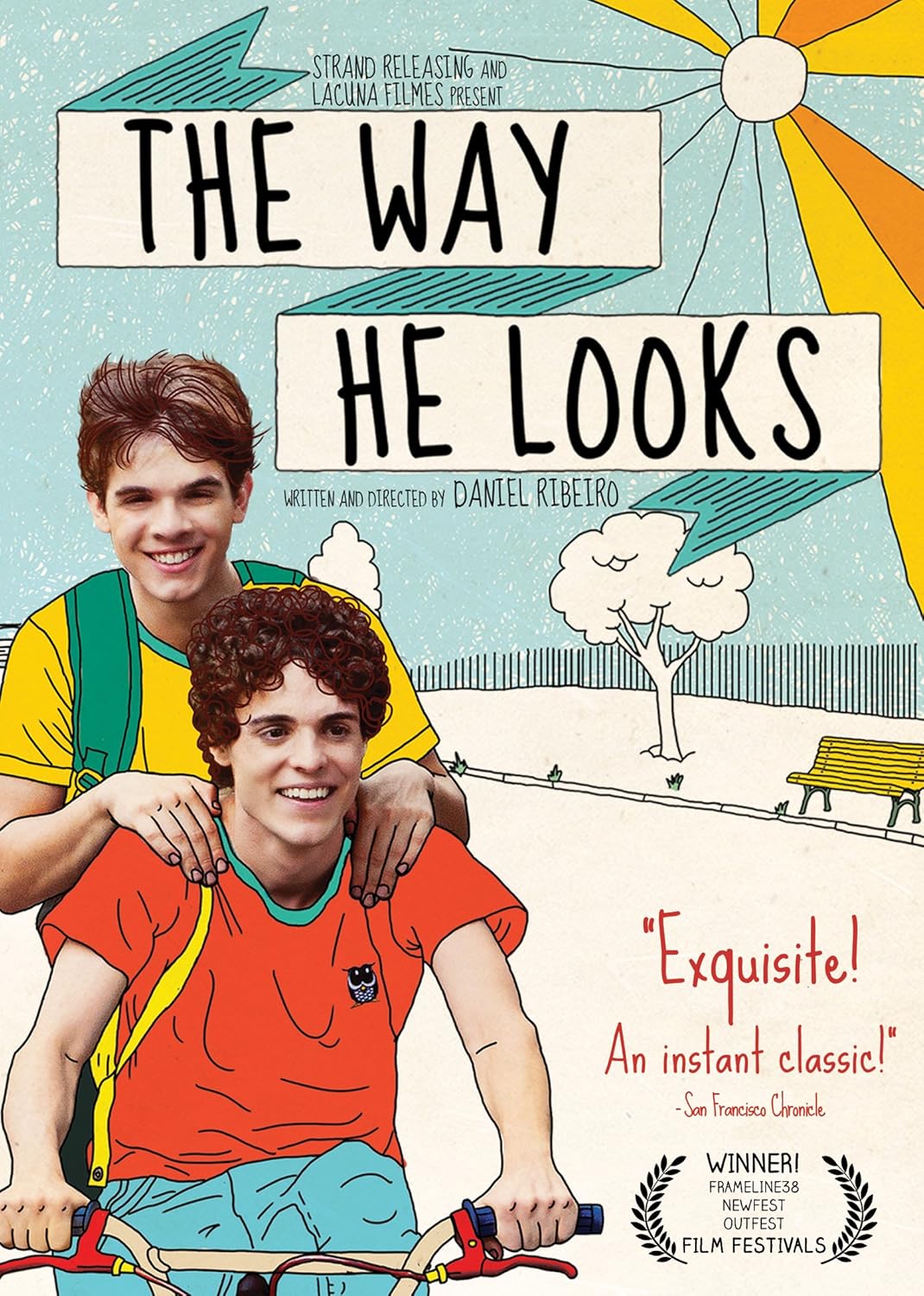
"The Way He Looks" (Hoje Eu Quero Voltar Sozinho), a 2014 Brazilian film directed by Daniel Ribeiro, offers a unique narrative that weaves together themes of queer identity, disability, and the universal experience of first love. It is a coming-of-age story, but with an approach that goes beyond conventional tropes, portraying the intersection of queer and disabled identities in a gentle, respectful, and deeply moving way.

In this article, we will delve into the significance of The Way He Looks, exploring how it challenges mainstream narratives around queerness and disability, its cultural impact in Brazilian cinema, and the importance of seeing LGBTQ+ joy on screen.
Plot Overview: The Simple Beauty of First Love
The Way He Looks follows Leonardo, a blind high school student, as he navigates the complexities of adolescence. Leonardo dreams of independence—he longs to study abroad and to be free from the overprotectiveness of his parents and the teasing of his classmates. His best friend Giovana often helps him get home from school, and the two share a close, platonic bond.
However, everything changes with the arrival of Gabriel, a new student who quickly befriends Leonardo and Giovana. As the three grow closer, Giovana begins to develop feelings for Gabriel, but it is Leonardo who finds himself unexpectedly drawn to him. The film delicately captures Leonardo's internal journey as he realizes that his feelings for Gabriel are more than just friendship and that this might be his first real experience of love.
Challenging Representations of Disability in Film
One of the most powerful aspects of The Way He Looks is its portrayal of Leonardo's blindness. In many films, disabled characters are often either inspirational figures whose stories revolve around their disability or they are portrayed as tragic or dependent. The Way He Looks takes a different approach, depicting Leonardo as a fully rounded character whose blindness is simply one part of his identity.
The film treats Leonardo's blindness with a matter-of-factness that is rare in mainstream cinema. Rather than focusing on the challenges of his disability, the narrative explores his desire for independence and self-determination, themes that any teenager—disabled or not—can relate to. Leonardo’s blindness is not his defining feature, but it does add layers of complexity to his journey toward self-discovery and love.
By showing Leonardo in situations typical of adolescence—his desire to break free from his parents' control, his longing for privacy, his confusion about his emerging sexuality—The Way He Looks humanizes him in a way that challenges typical portrayals of disabled characters. His blindness is part of who he is, but it is not what the film is "about." This allows viewers to see Leonardo as a whole person rather than a one-dimensional character defined by his disability.
Queer Identity and Self-Discovery
Leonardo’s blindness is only one aspect of his identity; the film also portrays his journey of coming to terms with his sexuality. As Leonardo develops feelings for Gabriel, the film delicately navigates his confusion, excitement, and fear. In many LGBTQ+ films, characters’ coming out experiences are fraught with external conflict—rejection from family, friends, or society at large. But The Way He Looks takes a refreshingly different approach.
The film focuses on the internal emotions Leonardo experiences as he realizes that he is attracted to Gabriel. Rather than facing dramatic homophobic backlash, Leonardo's journey is primarily about self-acceptance. This is not to say that the film shies away from the challenges LGBTQ+ people face, but rather that it offers an alternative narrative—one that prioritizes personal growth and the beauty of discovering one's true self without the overshadowing trauma.
The film's depiction of Leonardo's sexuality is nuanced and subtle. There are no big, dramatic coming-out scenes, and the film never feels the need to label Leonardo's feelings. This allows the film to focus on the universal experience of first love, making it accessible to both LGBTQ+ and non-LGBTQ+ audiences.
The Intersection of Disability and Queerness
One of the most compelling aspects of The Way He Looks is how it portrays the intersection of queerness and disability. There are very few films that explore both of these identities simultaneously, making The Way He Looks a groundbreaking film in this regard. By showing a queer protagonist who is also disabled, the film expands the boundaries of representation and challenges stereotypes about both communities.
The intersection of these two identities is handled with care and respect. Leonardo's blindness is not portrayed as a barrier to his sexuality, nor is it fetishized or sensationalized. Instead, the film emphasizes that Leonardo's desires, fears, and hopes are just as valid as those of any other teenager. His blindness may add complications to his relationships—such as when Gabriel teaches him how to dance or when Leonardo insists on walking home by himself—but it is never portrayed as a reason for him not to experience love and desire.
The film also avoids the pitfall of making Leonardo's disability the source of his insecurity about his sexuality. Instead, his journey is about the universal adolescent experience of trying to understand one's feelings and navigate romantic relationships for the first time. This intersectional portrayal of queerness and disability is a rare and important contribution to LGBTQ+ cinema.
Independence and the Struggle for Autonomy
Another central theme in The Way He Looks is Leonardo's desire for independence. As a blind teenager, Leonardo is constantly dependent on others, particularly his best friend Giovana, who helps him get home from school, and his overprotective parents, who worry about him constantly. Leonardo longs to break free from this dependency and prove that he can take care of himself.
This desire for independence is closely tied to Leonardo's sexual awakening. His relationship with Gabriel becomes a way for him to assert his autonomy and make his own choices about his life. This is most poignantly illustrated in the scene where Leonardo insists on walking home by himself after spending the day with Gabriel. It is a small act of defiance, but it represents a larger shift in Leonardo's sense of self.
Leonardo's blindness adds complexity to this theme of independence, but it is not the sole focus. Rather, the film portrays independence as a universal desire for all young people, regardless of their abilities. This makes Leonardo's journey relatable to a wide audience while also highlighting the unique challenges he faces as a blind person seeking autonomy.
Brazilian Cinema and LGBTQ+ Representation
In addition to its powerful portrayal of disability and queerness, The Way He Looks is also significant for its contribution to LGBTQ+ representation in Brazilian cinema. Brazil has a complicated relationship with LGBTQ+ rights. While same-sex marriage has been legal since 2013, the country continues to struggle with high rates of violence and discrimination against LGBTQ+ individuals.
The Way He Looks offers a hopeful and positive portrayal of LGBTQ+ love, which is especially important in a cultural context where LGBTQ+ people often face hostility. The film’s success, both in Brazil and internationally, demonstrates the growing demand for diverse and inclusive narratives in cinema.
By focusing on a story of queer joy and self-discovery rather than trauma, The Way He Looks represents a shift in how LGBTQ+ stories are told in Brazilian cinema. It offers a refreshing alternative to the tragic or sensationalized narratives that often dominate LGBTQ+ films, and it provides a platform for underrepresented voices.
A Story of Queer Joy
At its core, The Way He Looks is a story about love and self-discovery. What sets it apart from many other LGBTQ+ films is its emphasis on joy. Leonardo’s journey is not defined by suffering or conflict, but by the beauty of first love and the excitement of discovering who he is.
The film’s gentle tone and focus on positive representation make it an important contribution to LGBTQ+ cinema. It shows that queer stories do not always have to be about struggle or tragedy—they can also be about happiness, growth, and love. In a media landscape where LGBTQ+ characters are often relegated to the sidelines or portrayed as tragic figures, The Way He Looks stands out as a celebration of queer joy.
Conclusion: The Importance of Diverse Representation
The Way He Looks is a groundbreaking film that challenges conventional narratives around disability and queerness. Through its sensitive portrayal of Leonardo’s journey toward independence and self-acceptance, the film offers a rare and important representation of a queer disabled protagonist.
By focusing on themes of love, friendship, and self-discovery, the film resonates with audiences of all backgrounds, while also providing much-needed visibility for LGBTQ+ and disabled communities. Its success in both Brazil and internationally demonstrates the growing demand for diverse stories that reflect the complexities of real life.
As LGBTQ+ representation in film continues to evolve, The Way He Looks stands as a shining example of the power of cinema to challenge stereotypes, celebrate diversity, and tell stories that have often been left untold. It is a film that will resonate with anyone who has ever fallen in love, struggled for independence, or tried to find their place in the world.